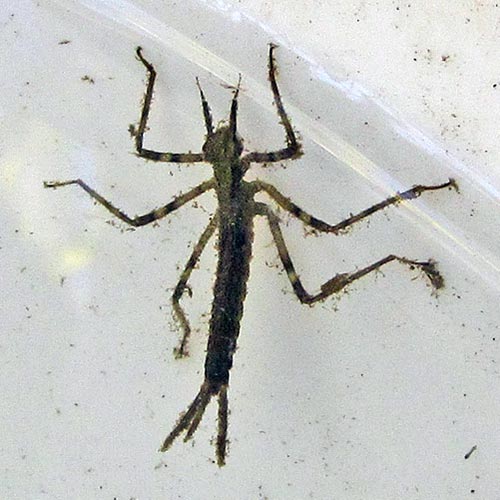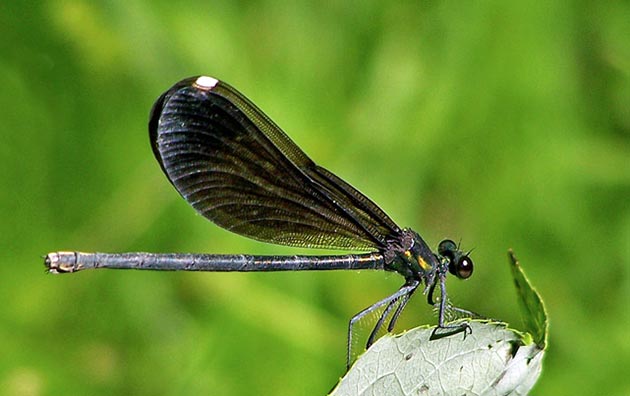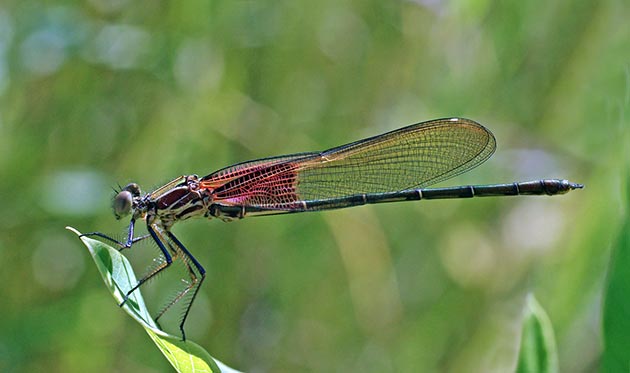Howdy, BugFans,
Damsel Flies
Recent episodes of BOTW have featured two families of the ethereal damselflies that grace our wetlands—the Spreadwings (family Lestidae) and the Pond damsels—forktails, sprites, dancers and bluets (family Coenagrionidae). Sharp-eyed BugFans probably noticed that identification of the species in these two families is not exactly a slam-dunk. The stars of today’s show are big (close to 2”), beautiful, unmistakable members of the third damselfly family, the Broad-winged damselflies (family Calopterygidae). Once again, the BugLady would like to recommend Damselflies of the North Woods by Bob DuBois, the Beginner’s Guide to Dragonflies, by Nikula, Sones, Stokes and Stokes, and the on-line Wisconsin Odonata Survey. There are eight species of Broad-winged damselflies in the U.S., and four of those are listed for Wisconsin at the Odonata Survey site—the River and Ebony Jewelwings, and the American and Smoky Rubyspots (the Smoky Rubyspot is recorded from only one county in the extreme southern part of the state).
Broad-winged damselflies get their name from the base of their wings, which taper gradually instead of looking “stalked.” When they sit, they hold their wings together vertically over the top of their abdomen. They come in metallic colors, with the males showier than the females, which sport a white spot (stigma) toward the tips of their wings.
[metaslider id=5208]
Like dragonflies and other damselflies, Rubyspots and Jewelwings are tied to the water—in this case, running water. Other Odonates may hunt far from streams and ponds, but the Broad-winged damselflies tend to be homebodies. Rubyspots seldom gain more than a foot or two in altitude, but the BugLady has seen jewelwings six feet off the ground. They are perchers—sitting on plants or rocks and sallying forth to hunt or to defend their territories. Like all Odonates, they are carnivores, both in their aquatic nurseries and as airborne adults, eating whatever small, soft-bodied invertebrates they can catch (and the young—naiads—love the equally aquatic mosquito larvae). They are eaten by a host of bugs, bats and birds, as well as by some fish, frogs and turtles.

Ebony Jewelwings (a.k.a. Black-winged damselflies) and American Rubyspots lay their eggs in the stems of submerged plants or in decaying wood in waters with a moderate current. Males guard but are not in contact with their ladies during egg laying. Their naiads, which are well camouflaged but not agile, move little and are found on vegetation under water. Broad-winged damselflies overwinter as naiads, and full grown naiads are about an inch long by the time they are ready to emerge as adults the next summer.
Ebony Jewelwings
Ebony Jewelwings (Calopteryx maculata) (beautiful wing with a spot) prefer streams in dappled woods east of the Rockies. They are said to be the most common damselfly in North America. Their main flight season is in June and July but a few hang around into September. Several sources testified about their approachability and the BugLady laughed a lot. In her experience, they like to maintain a personal space that puts them just a shade farther away than her camera can focus reliably. If she gets any closer, they hop to another perch. The flight of EJs is often described as “butterfly-like.”

EJ males have a stunning Kelly-green metallic head, thorax and abdomen, and the females’ colors are more muted.
Donald Stokes, in his wonderful Observing Insect Lives, reports that males are territorial. When an EJ spots an intruding male, he will attempt to chase it away. Plan B involves a behavior called “wing-spreading,” in which he psyches out his rivals by spreading his wings and raising his abdomen (raising the abdomen displays a bright, white spot under its tip). An approaching female rates a “cross-display,” in which the abdomen is raised, the hind wings spread, and the front wings folded (which sounds to the BugLady like simultaneously rubbing your head and patting your stomach—or was it the other way around?). According to Stokes, if a female is unimpressed, he flies around in front of her, faces her, and performs the irresistible “rapid-wing-flutter.” Both males and females have commitment issues. DuBois describes her as “blatantly promiscuous,” mating with four or five different males a day—for two weeks or so and nearly 2,000 eggs! Stokes says that as he is guarding her egg-laying efforts, the male is making cross-displays to nearby females (though he won’t pursue them until she is finished and out of sight).
American Rubyspot
The American Rubyspot (Hetaerina americana) likes larger streams and rivers; its range includes all of the lower 48 states (though there are no records for Idaho or Washington) plus the eastern half of Canada around the east edge of Hudson Bay. The AR is a late summer damselfly that notably gathers in groups (one observer caught 75 in a single net) and has been observed feeding in groups (swarm-feeding) on clouds of emerging mayflies. The reason for its name is obvious if you see a male in bright sunlight, but in shade they are not as conspicuous. The BugLady usually sees them as red dots on rocks in the river. The proximal third of the male’s wing is ruby/blood red, and while the female’s wing has a red wash at the base, its overall color is amber.

Males defend territories that change daily, chasing rival males in ever-widening circles until one poops out and flies off and the other claims/reclaims the spot. Females are also somewhat territorial, but neither gender has display behaviors like the Ebony Jewelwing. Receptive females fly into a territory, hover, and are grabbed/clasped by the male. As they fly in tandem to a perch to exchange bodily fluids, rival males may charge them and separate them. Duke University professor Clifford Johnson described how, still clasped, they may land on a floating mat of vegetation. The male walks backwards toward the water with the female backing up behind him until the female is fully submerged (several sources noted that she is partly to completely submerged while laying eggs, but she will enter the deep end of her own accord, too). She may stay under water briefly or for almost an hour (in fact, though other researchers have seen them, Johnson said he never saw a female re-emerge and wondered where/if they did). The male guards her from all comers—con-specific or not.
Ironically, those crimson wing spots that capture our imaginations make males potentially more visible to predators as they cruise low over the river’s surface, and, it turns out, they are also a “hunting handicap” that make males more visible to their own flying prey. In one study males (and females with red spots painted onto their wings) gained weight more slowly than the better-camouflaged “natural” females.
The Bug Lady